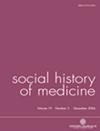Plague, Religion and Urban Space in Sixteenth-Century Antwerp
IF 0.7
2区 哲学
Q1 HISTORY
引用次数: 0
Abstract
Summary Antwerp’s response to the outbreak of plague in the 1570s offers new insights into the effects of epidemics on urban communities in relation to their religious, economic, and spatial fabric. Antwerp’s transition from a Catholic to Calvinist government in 1577, and back to Catholicism in 1585, allows us to study its reaction to and the effects of plague across religious boundaries within a short time span. Using GIS, we have compared various rich datasets concerning plague: the register of houses locked in quarantine; the health certificates issued by authorities; plague fatalities recorded in St. Jacob’s parish; a wide range of urban regulations; and information about the size of households, their composition, rents and real estate values in Antwerp. Combined analysis shows that Catholics and Protestants, whose houses were concentrated in different city districts and who had distinct professional and economic profiles, experienced plague quite differently, both physically and spiritually.十六世纪安特卫普的瘟疫、宗教和城市空间
摘要 安特卫普对 15 世纪 70 年代爆发的鼠疫的反应为我们提供了新的视角,让我们了解流行病对城市社区的影响与其宗教、经济和空间结构的关系。安特卫普在 1577 年从天主教政府过渡到加尔文政府,又在 1585 年恢复天主教政府,这使我们能够在很短的时间跨度内跨宗教研究安特卫普对瘟疫的反应和影响。利用地理信息系统,我们比较了与鼠疫有关的各种丰富的数据集:被隔离的房屋登记簿;当局签发的健康证明;圣雅各布教区记录的鼠疫死亡人数;各种城市法规;以及安特卫普的家庭规模、组成、租金和房地产价值等信息。综合分析表明,天主教徒和新教徒的房屋集中在不同的城区,他们的职业和经济状况也各不相同,他们在身体和精神上对鼠疫的感受也截然不同。
本文章由计算机程序翻译,如有差异,请以英文原文为准。
求助全文
约1分钟内获得全文
求助全文
来源期刊

Social History of Medicine
社会科学-科学史与科学哲学
CiteScore
1.60
自引率
0.00%
发文量
63
审稿时长
>12 weeks
期刊介绍:
Social History of Medicine , the journal of the Society for the Social History of Medicine, is concerned with all aspects of health, illness, and medical treatment in the past. It is committed to publishing work on the social history of medicine from a variety of disciplines. The journal offers its readers substantive and lively articles on a variety of themes, critical assessments of archives and sources, conference reports, up-to-date information on research in progress, a discussion point on topics of current controversy and concern, review articles, and wide-ranging book reviews.
 求助内容:
求助内容: 应助结果提醒方式:
应助结果提醒方式:


